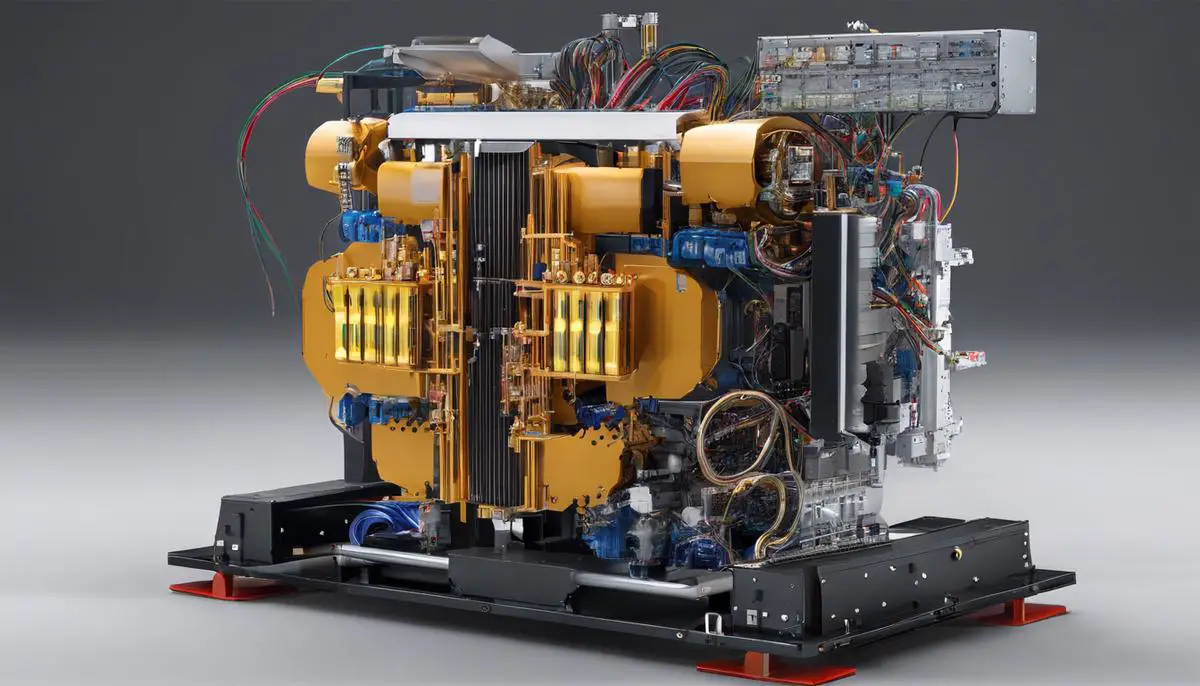Embarking on the exploration of the Generative Pre-trained Transformer, or GPT, plunges us deep into the realm where artificial intelligence brushes the canvas of human language with remarkable dexterity. At the core of this exploration lies an intricate dance of algorithms and neural network architectures designed to mimic the nuances of human language. As we unpack the layers of GPT, we unearth the transformative self-attention mechanisms that enable these models to parse and generate text with a finesse that blurs the lines between human and machine output. From the outset, our journey through the GPT landscape promises to demystify the complex interplay between machine learning models and the linguistic constructs they endeavor to replicate.
Fundamentals of GPT
Peeling Back the Layers: The Architecture of GPT Revealed
Ever wondered how GPT (Generative Pre-trained Transformer) manages to generate text that can fool us into thinking a human wrote it? GPT’s architecture is a fascinating blend of cutting-edge tech and brilliant design. Here’s a dive into the tech wizardry that makes GPT a real game changer in automated text generation.
The Core: Transformative Learning
At its heart, GPT is structured around something called a “transformer” model. What’s that, you ask? Think of it as the brain’s neural network, but for machines. Inspired by how humans process information, transformers use what is learned from vast amounts of data to predict what comes next in a sentence.
Training GPT: A Data Feast
Before GPT can sprout genius, it undergoes rigorous training. How rigorous? We’re talking about feeding it an Internet-sized banquet of text. From news articles to web pages, GPT munches on textual data, learning patterns, phrases, and linguistics quirks. This initially pre-trained model is the sturdy springboard from which GPT can then leap into various tasks.
Attention Mechanisms: The Spotlight of AI
Here’s where it gets really cool. GPT has an “attention mechanism,” which is like having a magnifying glass to focus on the important bits of the data. By learning what parts of the sentence matter most, GPT can generate replies or content that feels on topic and relevant. It’s like having an AI that actually understands the conversation’s context.
Layers and Decoders: The Building Blocks
Picture GPT as a tower with many floors. Each floor (or layer) of the transformer has what’s called ‘decoders’. As data moves up each floor, the decoders further refine the information, adding detail and nuance. By the time it reaches the top, the model is ready to spit out sentences that can mimic a human’s writing style.
Autoregressive Magic: Predicting the Future of Text
GPT works in an autoregressive manner. Basically, it makes its best guess for the next word, then the next, and so on—almost like a person trying to finish your sentences, but way better. This sequential approach is key in generating coherent and contextually appropriate content.
GPT Versions: From Good to Mind-Blowing
The first GPT was impressive, but now we have successors like GPT-3 that are even more potent. With more data, more layers, and thus more depth, GPT-3 is a powerhouse that can draft essays, solve coding issues, and even craft poetry.
The Upshot: Technology for a Smarter Future
GPT’s architecture is more than just cool tech—it’s a leap towards intelligent automation. With every iteration, this system gets closer to mastering the intricacies of human language, opening doors to innovations that could simplify life, revolutionize industries, and redefine the boundaries of artificial intelligence.
And that’s the architecture of GPT: a complex transformer model honed by vast data and sophisticated attention mechanisms, structured in deep layers, all working sequentially to produce human-like text. It’s a testament to human ingenuity and our relentless push to create tools that not only serve us but also inspire us. With GPT, the future of AI-driven text generation looks not just bright, but truly limitless.

Training Process of GPT
**Fine-Tuning GPT’s Genius – Behind the Intelligence of Generative Pre-training**
Imagine you’ve got a chef in your kitchen who can whip up any dish, from classic spaghetti to avant-garde cuisine. Now swap the kitchen for technology and dishes for sentences, and you’ve got GPT, a masterful language chef. The next question naturally is, how does this chef perfect such a wide array of ‘dishes’? It’s all about refinement and fine-tuning.
Once the GPT base is trained – you know, vast amounts of data and a complex transformer model in its core – the magic isn’t over. No, it enters the culinary school of text generation excellence: fine-tuning. This is where GPT really hones its skills to suit specific tastes, much like how a chef specializes after learning to cook everything under the sun.
Fine-tuning involves training the model on a narrower set of data. This is like going from cooking all conceivable cuisines to mastering Italian cooking – focus is on perfecting pastas and pizzas. For GPT, this targeted practice makes it better for certain tasks like medical advice or legal document analysis.
In this specialized phase, feedback is paramount. As in any good training, errors are corrected, and successes are reinforced. GPT, therefore, learns not only from raw data but also from its mistakes. With each iteration, it gets smarter, more agile with words, and more accurate in hitting the right notes – the culinary critiques of the text generation world.
Another element crucial to the fine-tuning stage is the introduction of hyperparameters. These are like the secret spices – they aren’t the main ingredients, but without them, the dish falls flat. Hyperparameters are settings that dictate how the model trains. They make sure this advanced tech doesn’t overcook its data stew by going too far in its generalizations.
Let’s not forget one important gadget every tech-savvy enthusiast has: automation. In fine-tuning GPT, powerful algorithms and computing resources automate the learning process, ensuring that each word it dishes out aligns with the flavor profile it’s aiming for.
Consider how a smartphone camera app is updated to make photos clearer and more vibrant. Similarly, GPT undergoes updates and tweaks, sharpening its output, polishing its grammar, and refining context understanding, without requiring someone to manually adjust its learning dials.
GPT’s fine-tuning also involves learning patterns of language and nuances of human communication, conducting this symphony of words with the finesse of a seasoned maestro. This phase is crucial, turning a good language model into a great one, custom-fitted to specific tasks or industries.
So, next time you encounter GPT crafting text that makes you pause and think, “How does it know that?” remember, it’s not just a heap of data and complex algorithms. It’s a carefully fine-tuned instrument, designed to harmonize with the specific notes of our human language. It’s the result of meticulous training, constant refining, and an unyielding commitment to learning – that’s what enables GPT to produce the seamless stream of words it’s known for.

Natural Language Understanding
Diving deeper into the world of Generative Pre-trained Transformers (GPT), let’s slice through the layers of its sophistication to understand how this language model chef masters the art of dishing out coherent language.
Imagine GPT as a novice cook. Initially, it knows the basic recipes – the syntax and grammar rules of language – but to truly impress with linguistic gourmet, it must undergo an intensive fine-tuning process. This stage is absolutely critical, honing the model’s ability to understand context and produce relevant responses, much as a chef refines their signature dish.
Fine-tuning GPT is akin to a culinary artist specializing in a specific cuisine, say, Italian. The base model, already prepped with a broad knowledge, is now fed (trained) with a hearty portion of Italian recipes (language examples), flavor profiles, and plating techniques (specific contextual information). The model absorbs these subtleties, enhancing its ability to whip up sentences that could pass off as native to a native Italian speaker’s palate.
Feedback, in both kitchens and training models, is a powerful ingredient. GPT relies on input from its performance (the linguistics equivalent of a taste test) to adjust and improve continually. Did it generate a sentence that’s out of place? Feedback helps it learn from such slips to better its future outputs.
Next, the hyperparameters – they’re like the knobs and dials of a stove. These settings are fine-tuned to control the cooking – or in this case, the training – process, ensuring the model doesn’t overcook (overfit) or undercook (underfit) its language generation.
In the realm of automation, fine-tuning GPT thrives on automated processes. These streamline the refinement of the model, systematically adjusting parameters and providing new data for it to learn from, much as smart kitchen gadgets automate tasks to achieve consistent culinary results.
For a more relatable picture, consider how smartphone camera apps receive updates to enhance photo quality. Fine-tuning GPT is similar; it’s about tweaking and perfecting its algorithm, so the language it generates is always snapshot-perfect.
But what about those special seasoning touches – the idioms, the cultural references, the humor? Through fine-tuning, GPT learns the intricate patterns and nuances that make human communication relatable and authentic. It absorbs the “spices” of language to craft text that resonates with human readers.
In essence, GPT becomes a symphony of carefully calibrated, harmonizing instruments, all resonating to the rhythm of human language. Through fine-tuning, this language model chef elevates from a fast-food joint to a Michelin star linguistic gourmet, splendidly serving up sentences that satisfy the discerning tastes of human communication.

Applications of GPT
Harnessing GPT: A Multi-Industry Revolution
Imagine a tool so versatile it can write like Shakespeare, calculate like Einstein, and offer solutions like a seasoned executive. Generative Pre-trained Transformers (GPT) are that tool, revolutionizing industries far and wide.
Revolution in Customer Service
Chatbots and virtual assistants have undergone a transformation, thanks to GPT. They’re not just regurgitating pre-written lines but engaging in meaningful conversation, understanding context, and resolving issues with unprecedented efficiency. Customer satisfaction ratings are soaring as wait times plummet and solutions are delivered on the first contact.
Breakthroughs in Content Creation
Content is king in the digital age, and GPT is its new scribe. Bloggers, social media managers, and news outlets harness it for generating articles, captions, and even poetry. This AI-driven content not only reads naturally but also captures the nuances of our rich human language.
Healthcare’s Diagnostic Assistant
In medicine, time is life. GPT is being adopted to analyze patient data, interpret medical records, and even suggest diagnoses and treatment plans. It is supporting doctors by navigating vast medical knowledge bases swiftly, leaving no stone unturned.
Legal Analysis on Speed Dial
Legal professionals work with a monstrous volume of texts. GPT swoops in as the analytical companion, searching precedence, dissecting case law, and drafting documents. It’s not replacing lawyers but amplifying their abilities to navigate complex legal terrain.
Financial Forecasting and Personalization
GPT doesn’t just understand language; it crunches numbers. Financial analysts are utilizing it for market analysis, predictive modeling, and crafting personalized investment strategies. Its ability to analyze trends from massive datasets is like a crystal ball in the world of finance.
Education Tailored to You
Education is personalizing at an unprecedented scale with GPT. It crafts learning materials and tests that cater to individual student needs. By understanding where a student struggles or excels, it provides just the right challenge to propel them forward.
Game Development and Narrative Design
Creators in the gaming industry are using GPT to write compelling narratives, create dynamic dialogues, and even code aspects of games. The resulting experiences are more immersive and responsive to player choices than ever before.
Productivity in the Workplace
From drafting emails to compiling reports, GPT is the new assistant in town. It understands context and creates documents that feel personally crafted. Workers are freed from mundane writing tasks, unleashing their creativity where it truly matters.
Language Translation and Preservation
Breaking language barriers, GPT helps in real-time translation, but that’s not all. It’s also preserving languages at risk of extinction by learning and documenting them, ensuring cultural heritages are kept alive for generations.
From entertainment to existential problems, GPT is not a distant dream of science fiction. It’s here. It’s now. It’s reshaping the world, one industry at a time. And keep an eye out – this technology is only just getting started.

Ethical Considerations and Challenges
Ethical Implications and Challenges of Generative Pre-trained Transformers (GPT) Models
As technology surges ahead, striking new ground with innovations like GPT models, it’s vital to discuss more than just the tech specs. It’s time to delve into the weightier matters lying beneath the surface—the ethical implications and challenges these language models introduce.
Bias and Fairness: A Thorny IssueFirst and foremost, bias in GPT models is a hard-hitting concern. These models learn from vast swathes of data from the internet, which is teeming with human prejudices. This learning process can lead to models inheriting and amplifying these biases. When technology outputs discriminatory content, the repercussions can range from perpetuating stereotypes to influencing opinions and decisions that affect lives.
Misinformation: Wielded Like a Double-Edged SwordAnother ethical challenge is the potential for GPT models to generate believable fake content. Imagine a world where distinguishing between fact and fiction becomes a Herculean task. Yes, there’s immense potential in creating educational articles and assisting writers, but there’s an equal risk of generating fake news and impersonating individuals, thus misleading audiences and manipulating public discourse.
Privacy: Walking on Thin IcePrivacy is another heat-packing issue. GPT models are often trained on public data. However, they can inadvertently memorize and regurgitate sensitive personal information. Solving this requires robust de-identification and data handling practices, which are not just tech solutions but ethical standards to uphold.
Intellectual Property: A New FrontierWho owns the content generated by a GPT model? If someone inputs the beginning of a story and the model finishes it, who is the author? As we venture into new territories of intellectual property rights with AI-generated content, clear guidelines and protocols need to be established to address ownership and copyright in the digital age.
Accountability: Who’s to Blame?When a GPT model makes a mistake or causes harm, where does the responsibility lie? Pinning down liability for actions of an AI entity is complex. Striking a balance between innovation and regulation is essential to ensure creators and users take responsibility for how they deploy these powerful models.
Autonomy vs. Automation: A Balancing ActThe ability to automate tasks is tremendous, but there’s a thin line between helpful automation and eroding human autonomy. Ensuring that GPT models augment rather than replace human roles is no small feat. Ethical deployment involves creating symbiotic relationships between humans and machines, not scenarios where people become mere overseers.
Accessibility: No One Left BehindFinally, technology has a notorious history of creating clusters of haves and have-nots. Ensuring equitable access to the benefits of GPT models is necessary to prevent widening the gap between the tech-empowered and those without access. Making this technology accessible also means making it understandable so that users know what’s going on behind the scenes.
Facing these ethical implications and challenges head-on is imperative. The decisions and strategies implemented today will shape the trajectory of GPT models and their impact on society. The discourse shouldn’t end here; as tech enthusiasts and responsible digital citizens, it is a collective responsibility to keep pushing for ethical considerations to be at the forefront of technological advancement.

The Future of GPT
GPT: Peering into the Crystal Ball of Language AI’s Future
Generative Pre-trained Transformers (GPT), the wizards of the written word, are set to evolve in ways that could reshape our interaction with digital devices and the internet. As tech enthusiasts abreast with every fluctuation on the tech horizon, what foreseeable advancements can we expect from GPT’s future iterations? Let’s dive in.
Language Mastery Beyond Human Parity
Future GPT models will likely surpass current thresholds of language understanding. Language is not just about stringing words together; it’s about context, culture, and emotion. Imagine GPT models that can detect nuances, slang, and even humor with precision that rivals, or surpasses, human abilities. This advancement could lead to virtual assistants that don’t just understand what’s being said, but how it’s said, adding empathy to their virtual toolbelt.
Granular Personalization
One size does not fit all, particularly in language. Predictive models will become even more personalized. GPT may evolve to tailor its responses not just to a specific industry or task but to individual users, learning from their habits, profession, and preferences to provide hyper-personalized communication—whether it’s drafting an email or generating a poem.
Real-Time Multilingual Capabilities
In an increasingly connected world, the demand for real-time translation is peaking. Future GPT models are likely to offer seamless real-time translation across a multitude of languages, breaking down language barriers like never before and enabling smoother, more inclusive communication across the globe.
Interdisciplinary Integration
GPT could integrate more deeply with other fields of AI, such as computer vision, to provide more context-aware interactions. Picture a GPT that doesn’t just understand the text but can reference and analyze content from images or videos to provide more comprehensive and accurate responses.
Ethical and Responsible AI
As GPT models grow more advanced, so does the need for ethical considerations. We can anticipate future versions to come with robust mechanisms addressing biases, ensuring fairness, and avoiding the generation of harmful content. Implementing these safeguards will become as crucial as the model’s ability to generate text.
Enhanced Human-AI Collaboration
Collaboration between humans and AI is tipped to become more synergistic. GPT might shift from being just a tool to a collaborator, helping to ideate, draft, and refine content in cooperation with human users, forming a new class of digital co-creation.
Quantum Leap with Quantum Computing
Tease apart the limits of processing power and what do you find? That’s right, the potential for quantum computing to catapult GPT forward. With quantum computing, future models could process exponentially more data at incredible speeds. This would allow for deeper, more complex models capable of astonishing levels of comprehension and content generation.
These developments are not the stuff of science fiction—they’re on the tech industry’s radar. With each gigabyte processed and model tuned, GPT is bounding towards a future where the line between human and machine-generated content becomes imperceptible. Whether we’re eager for an assistant that truly gets us, or we’re looking for help smashing through language barriers, the future GPT promises is nothing short of revolutionary for anyone who thrives on the edge of technology’s ever-expanding frontier.

Traversing the crossroads of linguistic prowess and computational power, GPT models stand as testaments to human ingenuity in the quest to replicate the intricacies of human communication. As this exploration peels back the curtain on a technology that continues to evolve and shape our digital discourse, we are left with a sense of awe at the potential aria of AI’s role in our society. The journey into the depths of GPT’s mechanism is much more than an academic pursuit; it is a pivotal narrative of how we, as a collective, choose to harness the boundless capabilities of artificial intelligence to sculpt our future communications, confront our ethical imperatives, and, most importantly, redefine the boundaries of what machines can achieve alongside humanity.

